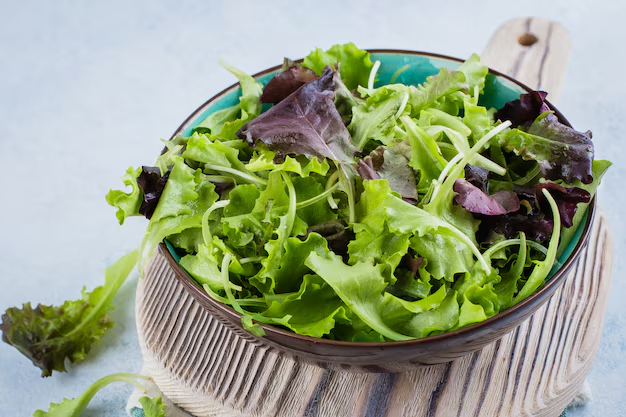Mesclun is a mix of young, tender greens that often includes a variety of leafy vegetables such as arugula, radicchio, baby spinach, and other lettuces. Known for its versatility and delicate flavors, mesclun has become a popular choice for salads, sandwiches, and garnishes around the world. In this comprehensive guide, we’ll explore everything you need to know about mesclun, from its origin and health benefits to how to grow it in your garden and use it in the kitchen.
What is Mesclun?
Mesclun is not a single plant but a blend of various young, leafy greens. The name “mesclun” comes from the French word “mescler,” which means “to mix.” The mix typically includes lettuces and other leafy greens, such as arugula, endive, mustard greens, and sometimes even herbs like parsley or basil. The specific combination of greens can vary depending on region, season, and personal preferences.
Mesclun is known for its mild yet slightly peppery flavor, which makes it an ideal base for salads, side dishes, and even as a garnish for more substantial meals. It’s enjoyed for its light texture and the variety of flavors it provides, all in one bowl.
History of Mesclun
The origins of mesclu’n can be traced back to Provence, a region in the south of France. Farmers in the area have grown a variety of leafy greens for centuries. Traditionally, mesclun was used as a way to make the most of available greens, which would be harvested young for their tender leaves and milder flavor. Over time, this practice spread across the world, and today, mesclun is enjoyed in numerous countries, including the United States, Canada, and various parts of Europe.
While it may have started as a humble mix of greens, mesclu’n is now considered a gourmet ingredient in many cuisines, often found in fine dining restaurants and served alongside exquisite dishes.
Benefits of Mesclun
1. Nutrient-Rich
Mesclun is packed with essential vitamins and minerals. It’s rich in vitamins A, C, and K, which support immunity, eye health, and bone strength. It also contains folate, which is vital for cell growth and function, making it a great addition to a balanced diet. The mix of greens also provides potassium and magnesium, both of which are important for cardiovascular health.
2. Low in Calories
Mesclun is incredibly low in calories, making it an excellent choice for those looking to maintain or lose weight. A cup of mesclun contains only about 10 to 15 calories, making it an ideal base for healthy salads without adding significant caloric intake. It also provides fiber, which promotes digestive health and helps you feel full longer.
3. Antioxidant Properties
The greens in mesclu’n are packed with antioxidants, including beta-carotene and various flavonoids. These compounds help fight free radicals in the body, reducing inflammation and lowering the risk of chronic diseases like heart disease and cancer.
4. Supports Digestive Health
Mesclun is rich in fiber, which aids in digestion and promotes a healthy gut. The variety of greens in mesclu’n provides different types of fiber, such as soluble and insoluble fiber, which support healthy bowel movements and prevent constipation.
5. Anti-inflammatory Benefits
Many of the greens in mesclun, such as arugula and mustard greens, contain compounds that have natural anti-inflammatory effects. These can help reduce the risk of chronic conditions associated with inflammation, such as arthritis and heart disease.
How to Grow Mesclun
Growing mesclun in your own garden is easy, and it’s a great way to enjoy fresh, organic greens. Here are the basic steps to growing mesclu’n:
1. Choose the Right Location
Mesclun grows best in cooler temperatures, ideally between 55 and 70°F (13 to 21°C). Choose a location in your garden that receives partial sun, especially during the warmer months when mesclu’n is more susceptible to bolting (flowering and going to seed). If you’re growing mesclu’n indoors, a sunny windowsill or a grow light will work well.
2. Prepare the Soil
Mesclun thrives in well-drained, fertile soil that is rich in organic matter. Before planting, amend the soil with compost or aged manure to improve its texture and fertility. Mesclun also prefers slightly acidic to neutral soil, with a pH between 6.0 and 7.0.
3. Plant the Seeds
Mesclun is typically grown from seed, which can be directly sown into the soil. Lightly scatter the seeds over the soil surface and press them down gently with a board or your hand. Mesclun seeds do not need to be buried too deeply—just about 1/8 inch (3 mm) deep is sufficient. Space the seeds about 1 inch (2.5 cm) apart to give them enough room to grow.
4. Water Regularly
Keep the soil consistently moist but not waterlogged. Mesclun requires regular watering to thrive, but too much water can cause root rot. It’s best to water early in the morning or late in the evening to avoid evaporation during the hottest part of the day.
5. Harvesting Mesclun
Mesclun greens grow quickly and can be harvested as early as 3 to 4 weeks after planting, when the leaves are still young and tender. To harvest, simply snip the outer leaves with a sharp pair of scissors, leaving the inner leaves to continue growing. This method, known as “cut-and-come-again,” allows you to harvest mesclu’n multiple times throughout the growing season.
Culinary Uses of Mesclun
Mesclun is incredibly versatile in the kitchen. Here are some popular ways to use it:
1. Salads
The most common use for mesclun is in fresh salads. Its mild, peppery flavor pairs well with a wide variety of dressings and toppings. Add fruits like strawberries or oranges, nuts like almonds or walnuts, and cheeses such as goat cheese or feta for a delicious salad. Mesclun also makes a great base for more complex salads, adding texture and freshness.
2. Sandwiches and Wraps
Mesclun can be used in sandwiches and wraps for added crunch and flavor. It pairs especially well with deli meats, chicken, or grilled vegetables. Spread some mustard or a light vinaigrette over the bread and top with a generous handful of mesclu’n.
3. Garnishes
Use mesclun as a garnish to add color and freshness to your dishes. A small handful of mesclu’n can be added to soups, roasted vegetables, or even fish and meat dishes for a light touch of greenery.
4. Smoothies
For a nutrient boost, you can add mesclu’n to your smoothies. Its mild flavor blends well with fruits like berries, bananas, and apples. The fiber in mesclun helps add bulk to your smoothie and can keep you feeling fuller for longer.
5. Pesto or Sauces
Blend mesclun into a pesto or sauce as an alternative to basil. The greens’ peppery flavor adds an interesting twist to traditional recipes.
Mesclun vs. Other Salad Greens: A Comparison
| Aspect | Mesclun | Romaine | Spinach | Arugula |
| Flavor Profile | Mild, slightly peppery | Mild and crisp | Mild, slightly sweet | Bold, peppery, mustard-like |
| Texture | Tender, leafy | Crisp, crunchy | Tender, succulent leaves | Tender yet slightly crunchy |
| Nutrient Content | High in vitamins A, C, and K; low in calories | High in fiber, vitamin C, and folate | Rich in iron, calcium, and vitamins A and C | High in vitamin K, antioxidants, and folate |
| Best for | Mixed salads, garnishes | Caesar salads, sandwiches | Smoothies, cooked dishes | Salads, pizzas, sandwiches |
| Growing Conditions | Cooler weather, full to partial sun | Warm weather, full sun | Cooler weather, partial to full sun | Warm weather, full sun |
Conclusion
Mesclun is not only a delightful addition to your meals but also a healthy, versatile, and easy-to-grow green. Whether you are a home gardener looking to add fresh produce to your garden or a culinary enthusiast wanting to elevate your dishes, mesclun is an excellent choice. From its nutrient-packed benefits to its ability to transform any dish, mesclu’n is more than just a salad green—it’s a staple in many kitchens worldwide.







